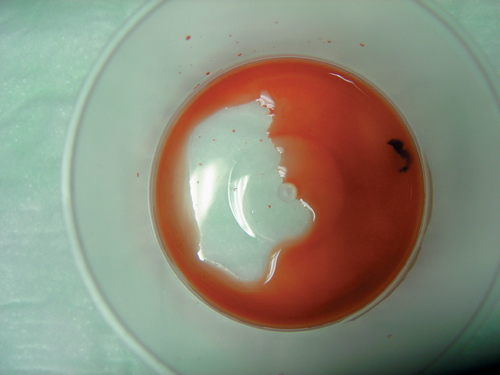Difference between revisions of "Rabbit Medicine and Surgery Q&A 20"
| Line 15: | Line 15: | ||
Haematuria may be diagnosed either by using a urine dipstick, with a positive reaction, or by examination of the urine sediment for red blood cells. <br><br> | Haematuria may be diagnosed either by using a urine dipstick, with a positive reaction, or by examination of the urine sediment for red blood cells. <br><br> | ||
Examination of the urine under a Wood’s lamp can distinguish between the two conditions, although this is rarely necessary in clinical practice. Porphyrin pigments will fluoresce, whereas haemoglobin does not. | Examination of the urine under a Wood’s lamp can distinguish between the two conditions, although this is rarely necessary in clinical practice. Porphyrin pigments will fluoresce, whereas haemoglobin does not. | ||
| − | |l1= | + | |l1=Haematuria |
|q2=What are the differential diagnoses for this condition? | |q2=What are the differential diagnoses for this condition? | ||
|a2= | |a2= | ||
| Line 22: | Line 22: | ||
*urinary tract disease (cystitis, bladder polyps, pyelonephritis, renal infarcts, urolithiasis); and | *urinary tract disease (cystitis, bladder polyps, pyelonephritis, renal infarcts, urolithiasis); and | ||
*lead toxicity. | *lead toxicity. | ||
| − | |l2= | + | |l2=Haematuria#Causes |
|q3=What further tests would you perform to reach a diagnosis? | |q3=What further tests would you perform to reach a diagnosis? | ||
|a3= | |a3= | ||
| Line 28: | Line 28: | ||
Radiography and ultrasonography may be used to investigate whether lesions are associated with the genital or reproductive tract. Contrast studies may be indicated with urinary tract disease. <br><br> | Radiography and ultrasonography may be used to investigate whether lesions are associated with the genital or reproductive tract. Contrast studies may be indicated with urinary tract disease. <br><br> | ||
Laboratory tests such as full haematology and biochemistry should be carried out. | Laboratory tests such as full haematology and biochemistry should be carried out. | ||
| − | |l3= | + | |l3=Haematuria#Diagnosis |
</FlashCard> | </FlashCard> | ||
Latest revision as of 12:26, 15 August 2011
| This question was provided by Manson Publishing as part of the OVAL Project. See more Rabbit Medicine and Surgery questions |
An owner is worried that her rabbit’s urine contains blood. She has brought in a urine sample for analysis.
| Question | Answer | Article | |
| How would you diagnose haematuria in the rabbit? | Rabbit urine can contain porphyrin pigments. This colours the urine dark brown to red and is often confused by owners with blood. |
Link to Article | |
| What are the differential diagnoses for this condition? | Differential diagnoses include:
|
Link to Article | |
| What further tests would you perform to reach a diagnosis? | A thorough history should be sought and a full clinical examination undertaken prior to obtaining a sterile urine sample, either by catheterization under sedation or by cystocentesis, for analysis and culture. |
Link to Article | |
